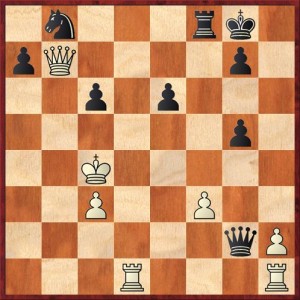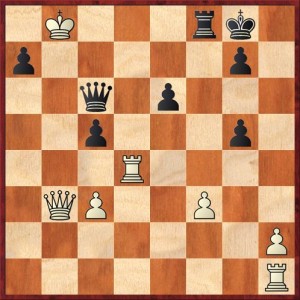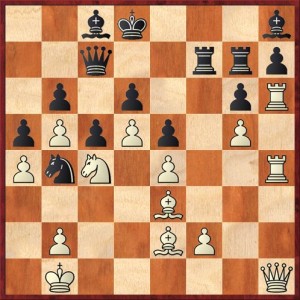This weekend I played in the Pacific Southwest Open in Los Angeles. Although I have lived in California for 17 years, I’ve only played two previous tournaments in southern California (both U.S. Opens). Of course, one reason is that California is a big state; it’s a six-hour drive from my home in Santa Cruz to Los Angeles. And there are plenty of events in northern California. So I just don’t come down here that often.
Anyway, I enjoyed the tournament, and it was fun to see a different collection of people from the ones I’m used to. One name I was curious about was Matt Noble, who turned out is not the Matt Noble I used to play back in North Carolina, but the two of them are Facebook friends. They should should really play a game some day! The chess world unfortunately never got to see a GM Larry Evans vs. IM Larry Evans game, but NM Matt Noble vs. Expert (and maybe someday NM?) Matt Noble would be a fun consolation.
As usual there were some people at the tournament who read my blog, and some who know about my ChessLectures, and others who saw my recent article in Chess Life … So I guess it’s really hard for me to be a stranger.
The open section had a sizeable contingent of International Masters. Two of them, Andranik Matikozyan and Niccolo Ronchetti, split the top prize with scores of 5-1. I had heard of Matikozyan, but Ronchetti is a new name to me. They earned $980 apiece for their weekend’s work.
My results were a mixed bag. On the first day I took two byes, because I was driving down from Santa Cruz. (As it turned out I got here in time for the second round, but I didn’t want to play when I was still tired from driving most of the day.) On day two I played pretty badly, with a loss and a draw (the latter out of an opening where I was completely winning).
But today, everything clicked. I won both of my games to finish with a score of 3½-2½. I was a little unlucky that that score didn’t win any prize money. But maybe that’s fair. You shouldn’t really win a prize when you don’t play one day, play badly the next day, and then have one good day.
What’s more important than the prize, or lack thereof, is the fact that I have two beautiful positions to show you. The first comes from my round 5 game against a class-A player named Shaurya Jain.
FEN: 1n3rk1/pQ4p1/2p1p3/6p1/2K5/2P2P2/6qP/3R3R b – – 0 23
Jain, who had White, has just played 23. Kc4 in hopes of escaping with his king to b3, after which he would have a decent chance to survive. But he never gets there! Can you see how Black wins this position by force?
The first move is 23. … Qa2+! This, of course, cuts off the king’s escape route. I’ll leave it to you to check that all four king moves lose: 24. Kb4 or Kc5 run into 24. … Na6+. Likewise, 24. Kd4 runs into 24. … Qd5+ and 24. Kd3 runs into 24. … Rxf3+. So White’s move, 24. Qb3, was more or less forced.
Now comes 24. … Rf4+!, a key move of the combination. White has to play 25. Rd4 or else lose his queen, but now White’s pieces unfortunately block all of his king’s retreat routes, and I played 25. … Qa6+!
I call it “moving your opponent’s pieces” when you force him to make moves like Qb3 and Rd4 that ultimately work against him. The rest was easy: 26. Kc5 Rf5+ 27. Kd6 c5+ (at this point it’s clear that Black is winning material, but of course I’m playing for mate) 28. Kc7 Qc6+! 29. Kxb8 Rf8+ 30. 0-1
FEN: 1K3rk1/p5p1/2q1p3/2p3p1/3R4/1QP2P2/7P/7R w – – 0 30
It’s mate after 30. Kxa7 Ra8. This was a very pleasing combination. I think it was the first time I have played a “king hunt” in the middle game that chased my opponent’s king all the way to my back rank. I also really liked the way that my knight on b8 played a crucial role in the attack, even though it never moved from its starting square!
My final game was a vastly different kind of game. My opponent was a young girl named Agata Bykovtsev, an expert (actually rated slightly above me) who played the King’s Indian Defense. I played 5. Ne2 against her, and she seemed to have no idea how to meet it. She got just an awful, completely paralyzed position. I managed to handle it in textbook style (I might even say Mike Splane style), waiting and waiting and waiting and gradually increasing my grip until (a) her time got low and (b) she allowed me a petite combination.
2bk3b/2q2rrp/1p1p2pR/pPpPp1P1/PnN1P2R/4B3/1P2BP2/1K5Q w – – 0 38
This one probably won’t be too hard for you to solve. I played 38. Nxb6!, a deflection sacrifice. After 38. … Qxb6 39. Rxh7 she has to take once on h7 or else lose her bishop: 39. … Rxh7 40. Rxh7. Now a key point of the combination is that 40. … Bg7 does not save the bishop because of 41. Rxg7! Rxg7 42. Qh8+. Likewise, 40. … Rxh7 41. Qxh7 also wins the trapped bishop. With only 3 seconds left on her clock, she played 40. … Rd7? after which 41. Rxh8+ Kc7 42. Bg4! wins either a piece or the exchange. She resigned here.
All in all, a good weekend’s work!






{ 7 comments… read them below or add one }
I’d really like to see annotations to the final game (not so much just the final combination, which is straight forward enough). As black, I would be thinking of opening up the long diagonal and the e5 point a la Petrosian with Rf4 at some point (see Tal-Petrosian http://www.chessgames.com/perl/chessgame?gid=1106392), which would then ask for a refutation by white. I am pretty sure that it doesn’t work for black because white has e5 strongly guarded.
It would be interesting to see how white got such an aesthetic position. The pawn wedge with Nc4 is something that people playing the English/KID formations dream about!
Hi Praveen,
Well, I’m saving the whole game for a possible ChessLecture. (I try to avoid just repeating my blog posts in my ChessLectures.) But to answer your questions… I got a little bit of help from my opponent to get that pawn structure. I put my knight on b5 and eventually she got tired of it being there and she took it. I don’t think she properly appreciated the fact that this wasn’t helping matters, it was in fact making them worse, because a knight on c4 can attack both the d6 and b6 pawns!
I did think about the possibility that Black might try an exchange sac on f4. One thing that kept her from doing it was the pressure on the h-file, although it’s possible she had an opportunity before I managed to set up “Alekhine’s gun” on that file.
In general I like the Ne2 system because it’s much harder for Black to get his (or her) normal King’s Indian-style pawn march going. First, I pre-empt it with my own advance h4-h5, and second, I either delay castling or castle queenside, so that the Black pawn storm has less reason.
I’d like to make one point about the second game that may be useful for your readers to know. In totally cramped positions like this, sacrificing a piece for a couple of pawns to achieve a breakthrough is the standard winning idea for the side with the extra space, so combinations like the one Dana played are not that unusual. Of course it always feels great to play something spectacular like this, especially so if you are unaware of the usual procedures.
I often tease Dana by saying “I prefer to sacrifice my opponent’s pieces” when he shows me one of his many spectacular positional pawn sacrifices, but this is one position where we would both play the same way. Well done, Dana!
Hi Dana,
Good to meet you in LA and nice write up of the tournament. Praveen and me are buddies and he linked me here.
You should consider a trip to Tucson, AZ. Good chess there and the style of play is a complete 180 from LA.
Hi Dana,
I was thinking about the first position and wondered what was wrong with 23. … Qe2+.
If 24. Kb3 Na6 threatens both 25 … Rb8 and 25 … Nc5+. I don’t see how White survives.
Likewise if 24. Rd3 Rd8 and however White guards the rook 25 … Nd7 and 26 … Ne5+ wins.
I’ll grant you that forcing mate with 23 … Qa2+ is a better line. I just wondered if you looked at this during the game.
Hi Mike,
I think you’re right, 23. … Qa2+ would have been excellent too. I didn’t mention this in my post, but I was starting to get into time trouble here (maybe 20 minutes for 17 moves — I’m not sure exactly). After I convinced myself that 23. … Qa2+ would lead to mate or win of the queen, I really didn’t look at … Qe2+. This violates the rule that if you see a good line you should look for a better one. I probably would have looked at … Qe2+ if I had more time.
This leads to an interesting question: How much should one modify one’s analytical procedure in time trouble? In time trouble, I am much more likely to pick one line and analyze it first, instead of making a list of candidate moves. This works great if I happen to pick a really good line to analyze first (as in this game). But if … Qa2+ hadn’t worked so well, then I would have been in a pickle — I would have invested a minute or two of my time and would be in the situation of having no other candidate moves prepared.
So your question was very apropos. I was patting myself on the back for working out this “brilliant” variation, but your question reminded me that my thinking procedure over the board was not flawless.
Hello Dana – I look forward to the lecture with interest. This game reminded me of another game that I had seen from Kasparov’s superb OMGP (http://www.chessgames.com/perl/chessgame?gid=1106327). Notice that here too, white (probably just for irritation’s sake) played the N to b5, and for some reason black falls in line and captures, giving c4 to the black N, which is invulnerable and perpetually attacks d6 – essentially comprising one permanent weakness which needs nurturing throughout. Thus black *needs* counterplay elsewhere or else we could simply argue that his game is finished in a loose sense. That you have a second weakness on the kingside to play with ensures that the game is won.
Strangely enough, I happened to be on the receiving end of a positional masterpiece but with a mirrored formation in the French and I am thankful to my young opponent (Kevin Moi) for the lesson. In that game, we had the black pawns on e6-f5-d5, and the white knight was on f4. I had mistakenly allowed c file control to my opponent there, which, together with the annoying Nf4 weakness rendered black totally without hope owing to the space disadvantage and lack of play. Interestingly (and totally out of context), Petrosian played the Benoni like the French too as in here: http://www.chessgames.com/perl/chessgame?gid=1019414.
{ 2 trackbacks }